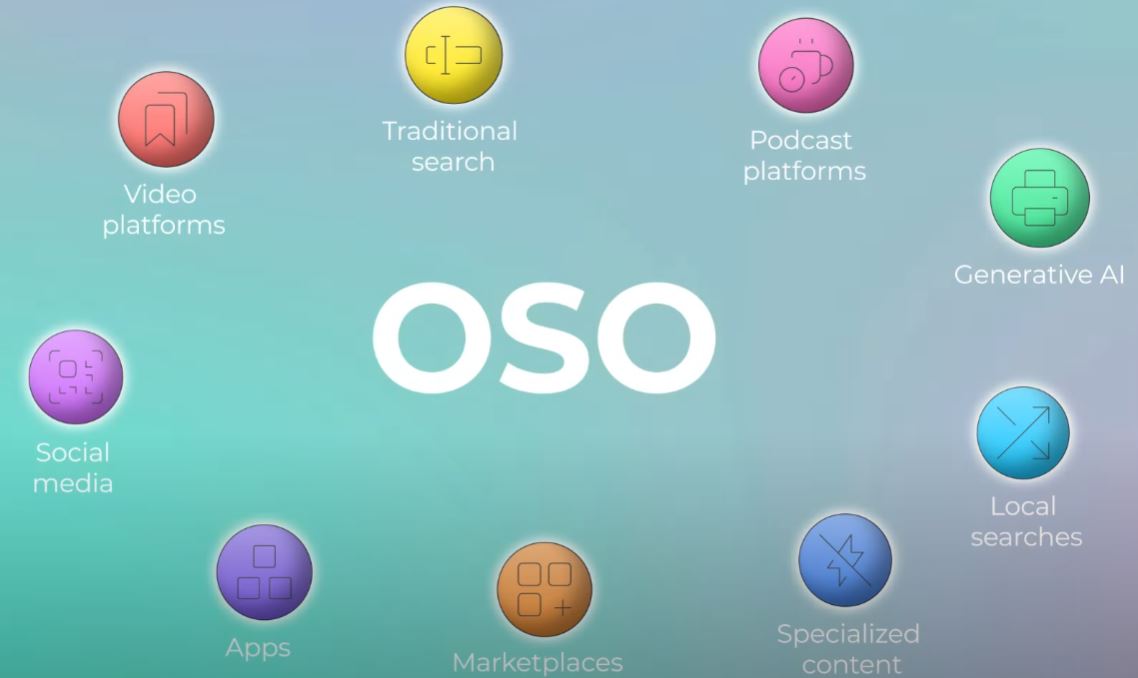The digital landscape has undergone a seismic shift in how people search for information. While Google remains dominant, nearly half of all searches now happen elsewhere—on social platforms like TikTok and LinkedIn, through AI assistants like ChatGPT and Perplexity, in app stores, marketplaces, and specialized forums. This fragmentation demands a new approach: Omnisearch Optimization (OSO). Unlike traditional SEO that focuses solely on search engines, OSO provides a comprehensive framework for visibility across all channels where your audience might be searching. At Cyberclick, we've already seen the power of this approach—with 50% of leads coming from social media and AI chatbots generating highly qualified prospects. This article explores how to implement OSO effectively across today's diverse search ecosystem.

Essential Channels for Omnisearch Optimization
Generative AI Platforms
The rise of ChatGPT, Perplexity, and Claude has created a new frontier for search optimization. These AI assistants prioritize clear, structured content that directly answers user questions. Unlike traditional SEO focused on clicks, AI favors authoritative sources that provide comprehensive, trustworthy information.
Key Optimization Strategies: Use conversational language in your content, structure information with clear headings, anticipate and answer common questions directly, and establish domain authority through recognized industry awards and positive reviews on platforms like G2 and TrustPilot.
Cyberclick's December 2024 data revealed 460 visits from ChatGPT with four highly qualified leads—demonstrating the tangible business impact of optimizing for AI search platforms.
Social Media Search
Platforms like TikTok, Instagram, and LinkedIn have evolved into powerful search engines, particularly for younger demographics. Each requires a distinct optimization approach:
TikTok/Instagram: Visual-first content with strategic hashtag use and trending audio. The platform's native search prioritizes engaging, authentic content that keeps users watching.
LinkedIn: Thought leadership content with professional keywords. Long-form posts and articles perform well for B2B searches.
X/Twitter: Conversational, timely content with relevant hashtags. Threads can rank well for topical searches.
Facebook: Community-focused content that encourages engagement. Groups often appear in search results.
"An industrial machinery company focusing only on technical blogs misses customers searching for tutorial videos on YouTube. OSO means being present where your buyer persona actually searches."
Video Platforms
YouTube remains the second largest search engine globally, while short-form video platforms like TikTok and YouTube Shorts are gaining search share. Optimization differs significantly between long and short formats:
| Platform | Optimization Focus | Content Strategy |
|---|---|---|
| YouTube | Title keywords, description details, chapter markers | Educational content, tutorials, product reviews |
| TikTok/Shorts | Hook in first 3 seconds, trending sounds | Quick tips, behind-the-scenes, snackable content |
For both formats, thumbnails play a crucial role in click-through rates. However, the content must deliver on thumbnail promises to maintain credibility and ranking.
Specialized Search Environments
Marketplaces & Local Search
E-commerce brands must optimize for marketplace search algorithms (Amazon, Etsy, etc.) which consider factors like product title keywords, reviews, and conversion rates. Local businesses need complete, optimized profiles on:
Google Business Profile: Complete all fields, add photos, encourage customer reviews
Yelp: Detailed business information, respond to all reviews
Apple Maps: Essential for iOS users
Industry-specific directories: Often rank well in local searches
App Store Optimization
With over 5 million apps across major stores, ASO has become as crucial as SEO for mobile-first businesses. Key optimization elements include:
App Title: Include primary keywords naturally
Description: Focus on benefits first, features second
Screenshots/Video: Show the app in action solving real problems
Ratings/Reviews: Positive ratings significantly impact ranking
Content Strategy for Omnisearch Success
Core Content Foundations
While expanding to new channels, traditional content marketing remains essential:
Blogs/Pillar Pages: Create comprehensive, evergreen content that establishes authority and attracts organic search traffic across topics.
Topic Clusters: Organize content thematically to improve discoverability and user experience.
Lead Magnets: High-value content upgrades (ebooks, templates) that convert visitors into known contacts.
Webinars/Reports: Position your brand as an industry leader while capturing qualified leads.
"The power of OSO comes from content repurposing—transforming a single webinar into social clips, blog posts, and quote graphics that work across multiple search environments."
Integrated Amplification
Effective OSO requires strategic content distribution:
| Tactic | Implementation | Channel Impact |
|---|---|---|
| Content Repurposing | Adapt long-form content into platform-specific formats | Extends reach across search ecosystems |
| Paid Amplification | Boost high-performing organic content with targeted ads | Accelerates visibility and lead generation |
| Remarketing | Re-engage searchers across channels | Increases conversion from all search sources |
Critical Insight: Focus on 3-4 channels where your audience is most active rather than spreading resources too thin across every possible platform. Quality presence beats mediocre omnipresence.
Omnisearch Optimization represents the inevitable evolution of digital visibility strategy. As search behavior fragments across platforms, brands must adapt their approach to meet audiences wherever they seek information—whether through AI assistants, social platforms, video, or specialized search environments. The future belongs to those who can integrate these diverse channels into a cohesive, audience-centric search presence.
